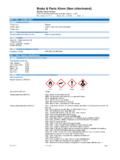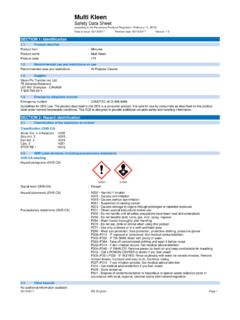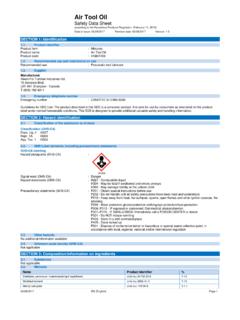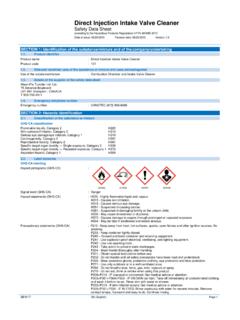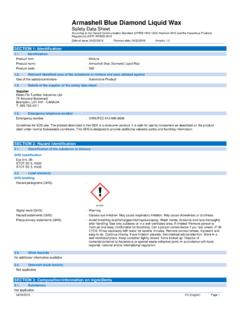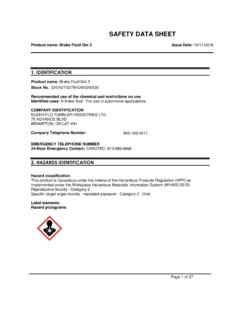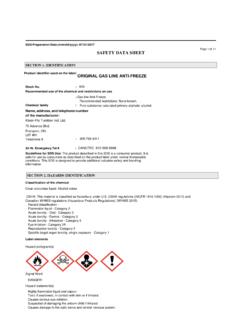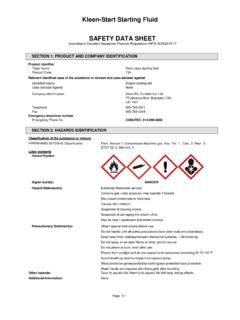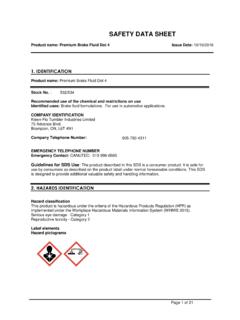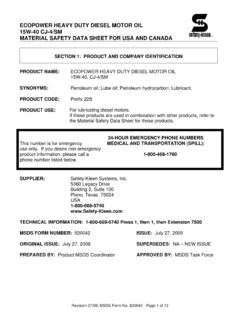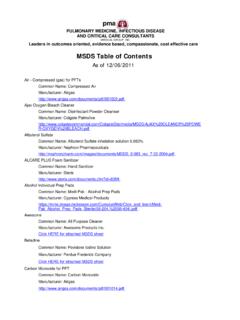Transcription of SAFETY DATA SHEET - Kleen-Flo
1 Product name: CHOKE & CARB kleen Product #: 820 Version #: 01 Issue date: 01-26-2017 SDS US 1 / 12 SAFETY data SHEET 1. Identification Product number Product identifier Company information Company phone Emergency telephone Version # Recommended use Recommended restrictions 2. Hazard(s) identification Physical hazards Health hazards OSHA defined hazards Label elements 820 Choke & Carb kleen Kleen-Flo Tumbler Ind Limited 75 Advance Blvd Brampton, Ontario L6T 4N1 Canada General Assistance 1-905-793-4311 CANUTEC: 613-996-6666 01 CLEANER None known. Flammable aerosols Acute toxicity, inhalation Skin corrosion/irritation Serious eye damage/eye irritation Reproductive toxicity Specific target organ toxicity, single exposure Specific target organ toxicity, repeated exposure Not classified.
2 Category 1 Category 4 Category 2 Category 2A Category 1B Category 3 narcotic effects Category 2 Signal word Danger Hazard statement Extremely flammable aerosol. Causes skin irritation. Causes serious eye irritation. Harmful if inhaled. May cause drowsiness or dizziness. May damage fertility or the unborn child. May cause damage to organs through prolonged or repeated exposure. Precautionary statement Prevention Obtain special instructions before use. Do not handle until all SAFETY precautions have been read and understood. Keep away from heat/sparks/open flames/hot surfaces. - No smoking. Do not spray on an open flame or other ignition source. Pressurized container: Do not pierce or burn, even after use.
3 Do not breathe gas. Wash thoroughly after handling. Use only outdoors or in a well-ventilated area. Wear protective gloves/protective clothing/eye protection/face protection. Response If on skin: Wash with plenty of water. If inhaled: Remove person to fresh air and keep comfortable for breathing. If in eyes: Rinse cautiously with water for several minutes. Remove contact lenses, if present and easy to do. Continue rinsing. If exposed or concerned: Get medical advice/attention. Call a poison center/doctor if you feel unwell. If skin irritation occurs: Get medical advice/attention. If eye irritation persists: Get medical advice/attention. Take off contaminated clothing and wash before reuse.
4 Storage Store in a well-ventilated place. Keep container tightly closed. Store locked up. Protect from sunlight. Do not expose to temperatures exceeding 50 C/122 F. Disposal Dispose of contents/container in accordance with local/regional/national/international regulations. Hazard(s) not otherwise classified (HNOC) None known. Supplemental information None. Product name: CHOKE & CARB kleen Product #: 820 Version #: 01 Issue date: 01-26-2017 SDS US 2 / 12 3. Composition/information on ingredients Mixtures Chemical name Common name and synonyms CAS number % Acetone 67-64-1 20 - 40 Propane 74-98-6 20 - 40 Xylene 1330-20-7 20 - 40 Diacetone Alcohol 123-42-2 - 10 Ethyl Benzene 100-41-4 - 10 Isobutane 75-28-5 - 10 N Methyl Pyrrolidone Mixture - 1 Toluene 108-88-3 - 1 *Designates that a specific chemical identity and/or percentage of composition has been withheld as a trade secret.
5 4. First-aid measures Inhalation Skin contact Eye contact Ingestion Most important symptoms/effects, acute and delayed Indication of immediate medical attention and special treatment needed General information 5. Fire-fighting measures Suitable extinguishing media Unsuitable extinguishing media Specific hazards arising from the chemical Special protective equipment and precautions for firefighters Fire fighting equipment/instructions Specific methods General fire hazards Remove victim to fresh air and keep at rest in a position comfortable for breathing. Oxygen or artificial respiration if needed. Call a POISON CENTER or doctor/physician if you feel unwell. Remove contaminated clothing.
6 Wash with plenty of soap and water. If skin irritation occurs: Get medical advice/attention. Wash contaminated clothing before reuse. Immediately flush eyes with plenty of water for at least 15 minutes. Remove contact lenses, if present and easy to do. Continue rinsing. Get medical attention if irritation develops and persists. In the unlikely event of swallowing contact a physician or poison control center. Rinse mouth. May cause drowsiness and dizziness. Headache. Nausea, vomiting. Severe eye irritation. Symptoms may include stinging, tearing, redness, swelling, and blurred vision. Skin irritation. May cause redness and pain. Prolonged exposure may cause chronic effects.
7 Provide general supportive measures and treat symptomatically. Keep victim warm. Keep victim under observation. Symptoms may be delayed. IF exposed or concerned: Get medical advice/attention. If you feel unwell, seek medical advice (show the label where possible). Ensure that medical personnel are aware of the material(s) involved, and take precautions to protect themselves. Show this SAFETY data SHEET to the doctor in attendance. Alcohol resistant foam. Powder. Carbon dioxide (CO2). Do not use water jet as an extinguisher, as this will spread the fire. Contents under pressure. Pressurized container may explode when exposed to heat or flame. During fire, gases hazardous to health may be formed.
8 Firefighters must use standard protective equipment including flame retardant coat, helmet with face shield, gloves, rubber boots, and in enclosed spaces, SCBA. Move containers from fire area if you can do so without risk. Containers should be cooled with water to prevent vapor pressure build up. For massive fire in cargo area, use unmanned hose holder or monitor nozzles, if possible. If not, withdraw and let fire burn out. Use standard firefighting procedures and consider the hazards of other involved materials. Move containers from fire area if you can do so without risk. Use water spray to cool unopened containers. In the event of fire and/or explosion do not breathe fumes.
9 Extremely flammable aerosol. 6. Accidental release measures Personal precautions, protective equipment and emergency procedures Keep unnecessary personnel away. Keep people away from and upwind of spill/leak. Wear appropriate protective equipment and clothing during clean-up. Do not breathe gas. Do not touch damaged containers or spilled material unless wearing appropriate protective clothing. Ventilate closed spaces before entering them. Local authorities should be advised if significant spillages cannot be contained. For personal protection, see section 8 of the SDS. Product name: CHOKE & CARB kleen Product #: 820 Version #: 01 Issue date: 01-26-2017 SDS US 3 / 12 Methods and materials for containment and cleaning up Environmental precautions 7.
10 Handling and storage Precautions for safe handling Conditions for safe storage, including any incompatibilities Refer to attached SAFETY data sheets and/or instructions for use. Stop leak if you can do so without risk. Move the cylinder to a safe and open area if the leak is irreparable. Isolate area until gas has dispersed. Eliminate all ignition sources (no smoking, flares, sparks, or flames in immediate area). Keep combustibles (wood, paper, oil, etc.) away from spilled material. Cover with plastic SHEET to prevent spreading. Absorb in vermiculite, dry sand or earth and place into containers. Following product recovery, flush area with water. Small Spills: Wipe up with absorbent material ( cloth, fleece).
